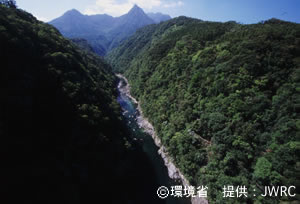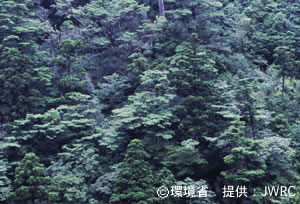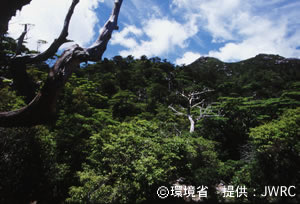The Yakushima Island is a treasury
of almost all kinds of Japanese vegetations. A large amount of subtropical plants
such as Japanese superb fig and Chinese Banyan grow on the coastlines. The evergreen
broadleaf forest with species such as Sudajii (Castanopsis cuspidata) and oak
trees abounds in the area from the lowland to 1,000 m above sea-level, as seen
in the temperate evergreen broadleaf forests in Tohoku to Kyushu districts. The
coniferous forest with species such as cedar, fir, hemlock fir and Japanese cypress
covers the large area of 700 m to 1,800 m above sea-level near the mountain peaks.
The virgin cedar forest is largely spread around the mountain peaks such as Nagata-dake,
Miyanoura-dake and Kuromi-dake. The forest also contains a combination of evergreen
broadleaf forest with species such as oak trees in the low altitude areas and
cool-temperate deciduous forest with species such as castor aralia (Kalopanax
pictus) and Acer sieboldianum in the high altitude areas.
Lastly the area near the mountain peaks of 1,800 m above sea-level consists
of the bamboo grassland of Yakushimadake (Pseudosasa owatarii) and the
subalpine scrub forest with rhododendron (Rhododendron yakusimanum)
and Sargent's Chinese juniper (Juniperus sibirica var. nipponica). Although juniper
normally inhabits in the alpine regions of Japan, the plant grows in Yakushima
where subtropical plants also exists. Yakushima is the southernmost island where
cool-temperate and subalpine vegetations are developed in Japan. For that reason,
Yakushima is the southernmost limit for many species growing in cold temperate
zones. Furthermore, there are many plants occurred in Yakushima in the course
of geological history, making the island abundant of endemic flora.
 Evergreen broadleaf forests, view from Matsumine-Ohashi bridge
Evergreen broadleaf forests, view from Matsumine-Ohashi bridge
 Natural forests, view from Anbo forest road
Natural forests, view from Anbo forest road
 Scrub forests near the mountain's summit
Scrub forests near the mountain's summit

 |